Osu! Tatakae! Ouendan (Nintendo DS) Review
By Mike Mason  16.11.2005
16.11.2005
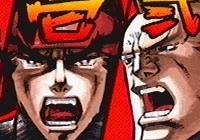
The developers of the obscure, sublime PlayStation 2 game Gitaroo Man, iNiS, have made their Nintendo DS début and are taking no prisoners, enveloping the system in another of their bizarre games in the form of musical cheerleading game Osu! Tatakae! Ouendan (the translation being ‘Go! Fight! Cheer’). Will it perform well or is it in need of some encouragement itself?
Ouendan is no ordinary game and it certainly doesn't have a traditional story, let that be known from the start. You take control of the Ouendan Squad, a group of male cheerleaders that look like they've raided a Nazi store cupboard for their grey, militistic uniforms, nicely finished with golden buttons running up the front. Red bands circle the leaders' biceps, with long, flowing headbands accompanying them in a similar bloody tone. They're not the poster children for cheerleading, as you may guess from this description; but judging by their performance here, they should be.
All around town, people are constantly trying to overcome their problems. Boys try to study for their exams while their family make an awful racket (a story I'm sure many can relate to). A secretary tries to catch the eye of her dashing boss despite her colleagues seemingly leading a brutal hate campaign against her. A man tries to stop his restaurant being terrorised by a calculating, conniving cat that enjoys marking its territory a little too much. All of these problems start out small and slowly snowball into bigger issues, and when things get just that bit too much, the inhabitants of the town know that they can call for help with a rousing cry of 'Ouendan!' Within seconds, the Ouendan squad will leap into action and provide support in their own unique way.
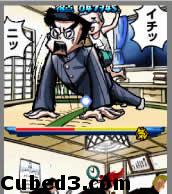
This is where you come in; you help the Ouendan Squad conduct their marvellous cheerleading routines by use of natural rhythm and the touch screen – by now, you may have guessed that it’s a rhythm game through and through. As the story unfolds on the top screen, the team appear on the bottom screen and move skilfully (or fall pathetically) as you play, which consists of you tapping numbered bubbles in ascending order. It all sounds so simple, and it is; to pick up, anyhow. As these bubbles appear, circles will close in around them, with the aim being to hit the bubble as the circle gets to the smallest it can before dissipating the bubble, and occasionally long lines will appear that you have to trace along in time to the music. If you hit bubbles perfectly you are awarded 300 points, hitting them well nets you 100 points, if only a moderately timed hit you get 50 points and if you completely mess it up you get a big fat zilch. An energy bar sits at the top of the play area and you have to keep it up by avoiding mistakes to stay in the action; if it drops to nothing, it’s game over. Describing it is both difficult and incredibly simple, as no matter how the gameplay is expressed the difficulty level of it cannot be accurately portrayed. Take our word for it – it’s not an easy game.
A few minutes are required to get used to the gameplay, but once you’re in and have attempted a song a few times, things feel a lot more natural. Every so often a sharp difficulty spike will be thrusted in your direction, and you will fail repeatedly until you’re ‘playing’ the song in your sleep with rapid taps and drags of your stylus hand. These changes in difficulty help to extend the game and ensure that you don’t finish it too quickly, and it doesn’t feel forced either – as you progress and the stages become gradually more difficult (and often far more fun because of it), you revel in the new challenges it sets. It’s difficult, but never unfair; any mistake you make is solely your fault, and the game will take great pleasure in making sure you know this - the more mistakes you make, the closer a leering team leader will come to the screen to put you off even more. Well, if you’d just followed the routine properly in the first place, you wouldn’t have to put up with that kind of abuse…
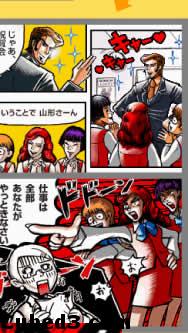
The problems you’re working towards solving with start off ‘simply’ enough in life terms. The aforementioned examples of the revising boy and the love-blinded secretary, in addition to the likes of a teacher trying to gain respect from his pupils, amongst others, are endearingly close to real life. While they might be depicted in a slightly more zany fashion due to the manga stylings, the problems are easily relatable, and this gives the game a strangely homely appeal, despite it being about as Japanese as you can get. This makes later events stand out even more, yet somehow they don’t feel out of place – not even when you’re combating a giant rat in the middle of a metropolis, or a surge of invading robots. Just enough insanity is injected into the ‘normal’ problems to make everything slot in together nicely, a sign of a well smoothed out game for sure.
Everything about the presentation in Ouendan is polished to near perfection. The menu screens burst with life, the stories for each chapter unfolding with manga panels at the start, end and during the gameplay. If you want to watch the in-game story activities (which you’ll have probably missed due to frantic rhythm keeping), there’s a replay option immediately after completing the level, allowing you to see how you did and how the story was reacting to your performance; you see, depending on whether you do well or not in each section of the song, the story will alter accordingly. These comic strips are drawn beautifully and give a huge amount of characters to the title; it simply wouldn’t be the same without them. The other advantage of this visual storytelling means that the language barrier is non-existent, everything being basically understandable to anybody. The over-the-top, hysterical pictures tell most of the story with only slight bits of text being unknown to those that aren’t educated in the Japanese language, and there isn’t even much text on the menu, meaning that just about anybody could pick the game up and work out how to play after a few minutes. The few items on the menu screens can be worked out with just a few moments of the good old technique that we like to call ‘trial and error’.
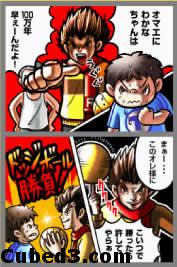
Being a music game, it’s pretty much essential that the score should be excellent, and it doesn’t disappoint. A fifteen-track mix of Japanese pop and rock fills the cartridge to its brim, none of which we’ve ever heard (or heard of) before. This doesn’t detract from the experience in any way though and in fact makes it feel quite fresh. There are rumours of an English release, but it’s likely that if it was unleashed on the English speaking world the charming music would be replaced with some abysmal Americanised music, so this is probably a case where the game should be left well alone in its current form. The sound brings up the other aspect of language that could pose a problem of sorts to players outside of Japan, that being the lyrics of the songs, but when they sound so good and fit so well into the game, what do those matter? The songs are fantastic enough to make you forget you can’t even understand it very quickly; music’s a universal language, after all.
It’s a very replayable game too. Even after you’ve completed levels you’ll probably want to go back and beat them again to try and best your score – you’re graded on your performance, and of course that human desire to compete means that everybody wants to get the best grades on everything. There are also a variety of difficulty settings to play through, each with their own different Ouendan Squad, with the final one being some more traditional looking female cheerleaders. Their chants are nowhere near as satisfying as the male ones, but their routines are far more complex – beware the female of the species.
Regardless of the (limited) language barrier and the weirdness of Osu! Tatakae! Ouendan, should it be considered a worthy purchase? The answer is a hearty yes, yes, yes. Not in a long while has a game made us grin this much, even as we fail a level yet again. ‘Just one more go!’ is cried out every time a level is lost; a resounding ‘yes!’ is heard when a level is finally completed (after a solid hour of trying in one case – the fact that a single level was still interesting after an hour continuously shows what pure gold we’re talking about, here), and all for good reason. Ouendan is simply one of the best games out on the DS, exuding charm even before you’ve left the title screen and satisfying to the very end, helped along by the beautiful visuals and heavenly sound. If you have the means, get over to eBay, Lik-Sang, wherever you like, just buy it, now.
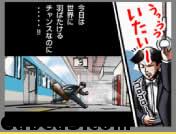
Cubed3 Rating
Exceptional - Gold Award

Looking for a decent rhythm game? Osu! Tatakae! Ouendan is your ticket to musical paradise. You may feel a little wary of playing or even buying a game that looks as bizarre as this, but play it and you'll likely fall in love with it. Do yourself a favour, throw caution to the wind and get this. OUENDAN!
Comments
Comments are currently disabled

 Sign In
Sign In Game Details
Game Details
 None
None  None
None  Out now
Out now  None
None  Subscribe to this topic
Subscribe to this topic Features
Features





 Top
Top

